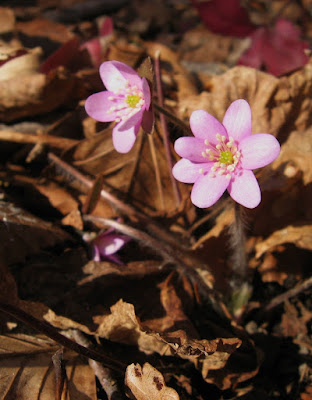 On Mackinac, one of the first flowers to bloom is Hepatica - and I spotted some today. Hepatica flowers early, before the trees leaf out, emerging from the leaf litter to nod in the breeze.
On Mackinac, one of the first flowers to bloom is Hepatica - and I spotted some today. Hepatica flowers early, before the trees leaf out, emerging from the leaf litter to nod in the breeze.This strategy allows the wildflowers to utilize the sun’s energy to photosynthesize while the sun's rays are still able to reach the forest floor. In the case of hepatica, the leaves produced in the spring of one year remain on the plant throughout the year and into the next spring’s blooming period. The leaves may photosynthesize to a minor extent on warm winter days and are ready to begin full photosynthesis before the leaves of other plants have even appeared.
So, hepatica is able to produce its flowers earlier than other spring wildflowers. The old leaves wither only after the flowers have begun to form fruits and new leaves are produced. By May, fresh green leaves unfurl and begin to capture the sun’s energy once again.
Hepatica is a member of the Ranunculaceae, or buttercup family. When Linnaeus published his Species Plantarum in 1753, in which he gave two-part names to species of plants and animals, he used the name Anemone for the genus of hepatica. Throughout the years hepatica has been placed back and forth again from Anemone to Hepatica by different taxonomists. Botanists currently place these plants in Hepatica.

 It’s from the leaves that both the scientific name, Hepatica, and the common name, liver-leaf, originated. The leaves are lobed and typically become a deep burgundy color as they age, attributes that reminded people of the shape and color of a liver.
It’s from the leaves that both the scientific name, Hepatica, and the common name, liver-leaf, originated. The leaves are lobed and typically become a deep burgundy color as they age, attributes that reminded people of the shape and color of a liver.Early herbalists often looked to a plant to give some sign of what it might be used for, a belief called the Doctrine of Signatures. In the case of hepatica, the resemblance of its dark, lobed leaves to a human liver indicated that it should be efficacious in treating diseases of the liver. In the late 1800s, hundreds of tons of the leaves were gathered for use in patent medicines. Demand was so great that additional quantities of the dried leaves had to be imported from Germany. Analysis of the chemical constituents of the plants has not found any components with documented medicinal value.
Hepatica flower stalks emerge clothed in a protective “fur coat” to help insulate them from the cool temperatures that prevail in April. Both flower stalks and the young leaves clustered at their base are covered in these downy hairs. The flowers are usually produced before the new leaves expand. The dark leathery leaves from the previous season help to make the plant somewhat easier to spot among the brown leaf litter.

I had no expectations of spotting any wildflowers when I was out and about today, but I was quite pleasantly surprised, and I have the muddy knees to prove it!


What beautiful pictures of exquisite flowers!!! thank you so much for the botany lesson-absolutely fascinating!!!!!
ReplyDeletegreat photos and wonderful additional info. love the flowers among the dried leaves of winter.
ReplyDelete